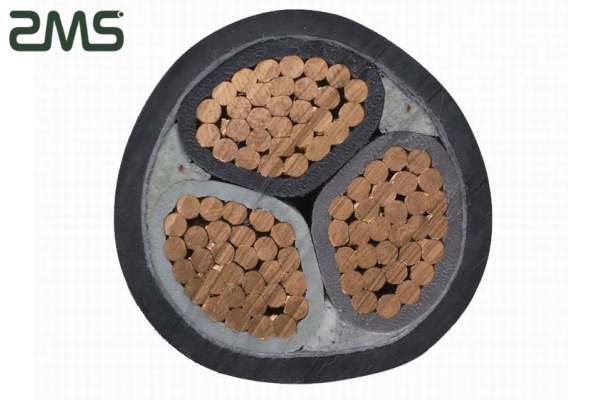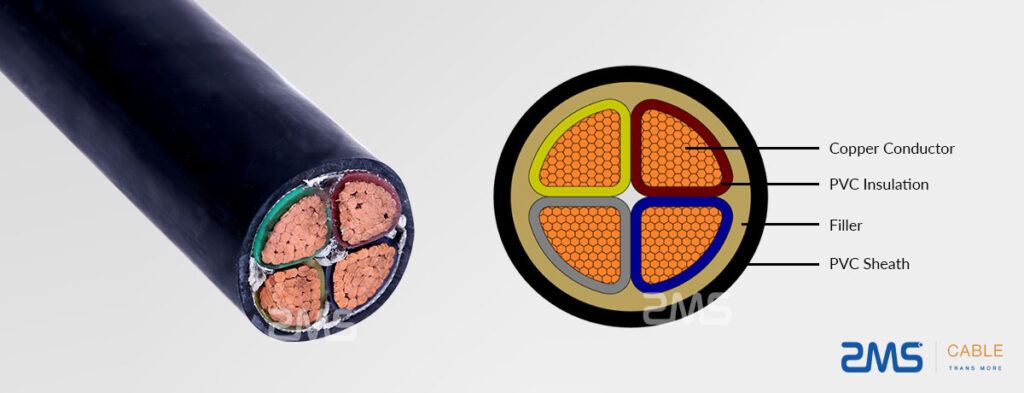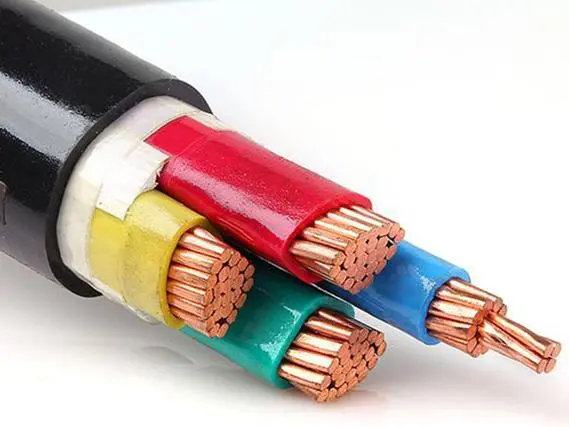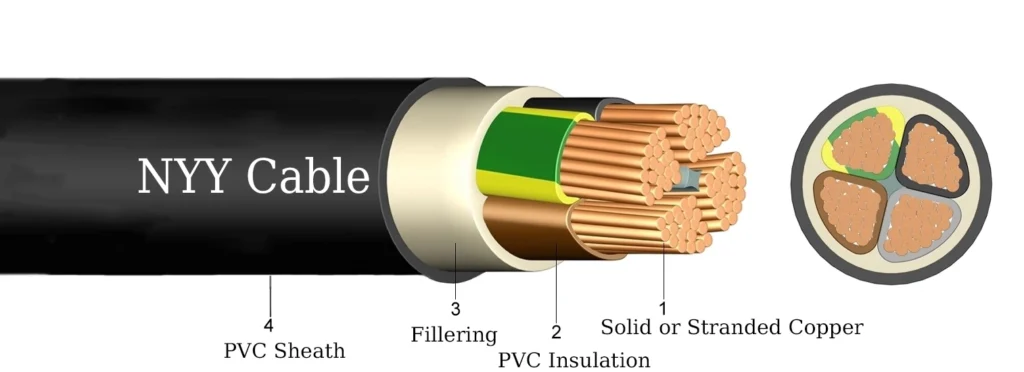NYY Cable Overview
The NYY cable is a double-sheathed power cable compliant with European standards, such as the VDE 0276-603. It is a low voltage cable designed for fixed installation and widely used in building sectors, industry and energy. It offers excellent weather resistance, reinforced mechanical protection and great electrical stability.

The acronym “NYY” comes from the German VDE standards :
N : copper driver (Standards management, standard driver) ;
YY : PVC insulation and outer sheath.
Depending on the presence of an earth conductor, the NYY cable is available in two versions :
Ny-j : equipped with a two-tone green/yellow earth conductor, suitable for installations requiring mandatory earthing ;
NYY-O. : without dedicated earth conductor, intended for applications where grounding is provided by another circuit or is not required.
The history of NYY cable dates back to the second half of the 20th century, as part of the electrical standardization process in Europe. Its design combines safety, sustainability and profitability. Thanks to its double PVC sheath, it offers excellent waterproofing performance, UV resistance and protection against chemicals. As an essential cable for low voltage power distribution, NYY is widely used in industrial applications, tertiary sectors and renewable energies.
International standards and certifications of NYY cable
The manufacturing and testing of NYY cable strictly conforms to several international standards :
Standards
VDE 0281/HD 603 : defines the cable structure, conductive materials and electrical performance ;
IEC 60502-1 : specifies the thickness of the insulation, voltage level and other parameters of low voltage cables ;
IEC 60332-1 : evaluates the fire behavior of individual cables by testing their resistance to flame propagation.
Industrial certifications
Certification TÜV : certifies the conformity of the cable with European safety directives, such as LVD 2014/35/EU ;
CE marking : guarantees that the product meets European health requirements, environment and safety ;
RoHS Compliance : ensures the absence of dangerous substances such as lead and cadmium, in accordance with environmental regulations.
Environmental requirements
The sheath is made of halogen-free PVC, limiting the emission of toxic gases in the event of fire ;
The manufacturing process is ISO certified 14001, guaranteeing responsible environmental management.

NYY cable structure and materials
NYY cable adopts composite multi-layer structure ensuring stable operation in demanding environments.
Driver
Material : high purity copper (class driver 1 or 2), conductivity ≥ 98 % Iacs ;
Sections available : of 1,5 mm² à 95 mm², with configurations ranging from single-phase to multi-conductor (until 60 drivers).
Isolation
Thickness : Compliant with IEC standard 60502-1, with a minimum thickness of 0,8 mm for a conductor of 1,5 mm² ;
Features : PVC resistant to temperatures of -40 °C to +70 °C, with enhanced protection against UV and chemicals.
Sheath
PVC double sheath :
Inner layer : provides mechanical protection ;
Outer layer : improves tensile and weather resistance.
Color customization : black by default, with possibility of specific colors according to customer needs.
Earth conductor identification (only for NYY-J)
Two-tone green/yellow core, VDE compliant 0293, intended for grounding equipment to ensure electrical safety.

Performance and technical advantages
Electrical performance
Tension nominale : 0,6/1 kV, test voltage 4 kV (CA, 50 Hz) ;
Isolation resistance : ≥ 300 MΩ·km to 20 °C.
Mechanical performance
Radius of curvature :
Unipolar cable : ≥ 15 times the outside diameter ;
Multipolar cable : ≥ 12 times the outside diameter.
Tensile strength : sheath resistance ≥ 12,5 N/mm².
Environmental adaptability
Temperature range :
Installation fixe : -40 °C to +70 °C ;
Installation mobile : -5 °C to +50 °C.
Protection index : IP67 (with specific protective sheath for buried or underwater installation).
Safety Features
Fire behavior : Compliant with IEC standard 60332-1, carbonization length after combustion ≤ 2,5 m ;
Oil resistance : the sheath is designed to permanently resist mineral oils and greases.
Applications
Main areas of application
Connecting industrial equipment
Suitable for powering heavy machinery and equipment, providing stable performance in demanding industrial environments, such as powering factory motors and automation systems.

Construction and construction sites
Used for temporary installation of cables on construction sites, providing the energy necessary for construction machines to ensure the continuity of work.
Transport et infrastructures
Provides power supply to urban transport systems such as the metro and tram, guaranteeing the proper functioning of infrastructure.
Energy sector
Key component in renewable energy projects, notably wind and solar, allowing the connection of production equipment to the electrical network.
Residential electrical systems
Used for household wiring, guaranteeing a reliable and secure power supply, suitable for fixed installations in dry or humid environments.
Other applications
Agricultural facilities
Powers automated equipment and irrigation systems, meeting the specific requirements of agricultural environments.
As a power cable, it allows flexible use in scenarios with moderate mechanical constraints, such as powering discontinuous mobile equipment (suitable for PVC).
Comparison between NYY cable and other models
| Features | Câble Nyy | YJV cable (cross-linked polyethylene – XLPE) | Fil BV (rigid copper) |
| Insulation material | PVC/XLPE | XLPE | PVC |
| Thermal resistance | -40℃ to +70 ℃ | -40℃ to +90 ℃ | -15℃ to +70 ℃ |
| Mechanical resistance | Double gaine, high compressive strength | Gaine simple, medium resistance | Without sheath, vulnerable to damage |
| Areas of application | Installation fixe | Fixed installation for high current | Short distance domestic wiring |
Comparison between NYY-J and NYY-O cables
The NYY-J and NYY-O cables are two variants of the NYY range, showing notable differences in terms of structure, functionality and applications.
Structural differences
| Setting | Ny-j | NYY-O. |
| Protective driver | Includes two-tone yellow/green ground wire | Without dedicated ground wire |
| Identification | White numbering + yellow/green wire | White numbering only |
| Applicable standards | Environments requiring grounding | Fixed installations without grounding requirements |
Technical analysis :
The NYY-J incorporates a ground conductor (yellow/green wire), strengthening electrical safety, ideal for high risk environments such as wet areas, underground or submerged.
The NYY-O does not have a ground wire, which reduces costs. It is suitable for dry environments or installations with an independent earthing system.
Application differences
| Sector | Recommended Applications for NYY-J | Recommended Applications for NYY-O |
| Industry | Wet workshops, grounding of equipment | Dry plants, distribution fixe |
| Building | Underground conduits, swimming pool supply | Interior wiring, lighting systems |
| Energy | Grounding loops for photovoltaic power plants | Ungrounded sections of wind turbines |
Three types of conductors of NYY — RE cables, RM, SM
Driver design NYY cables directly influences their electrical performance and applications. They are mainly divided into three categories :
RE (Round solid conductor)
Structure : Round solid conductor, used for cables with small cross sections (as 1.5-16 mm²), For example, NYY-J 1X4 RE SW, NYY-J 1X16 RE SW, etc.
Features : High mechanical resistance, suitable for fixed installations, reduced cost, but relatively large radius of curvature (15 × outside diameter).
Applications : Burial in buildings, underground conduits, etc., for applications without frequent movements.
RM (Multi-stranded round conductor)
Structure : Conductor made of fine copper wires twisted to form a circular section. Generally used for medium section cables (as 25-35 mm²), such as NYY-J 1X25 RM SW and NYY-J 1X35 RM SW.
Features : Greater flexibility than RE, Ray of curvature of 12 × outside diameter. High resistance to fatigue, suitable for environments subject to light vibrations.
Applications : Internal connections of industrial equipment, temporary power supply on construction sites.
SM (Fan-shaped twisted conductor)
Structure : Conductor twisted and compressed to form a fan-shaped section. Suitable for cables with larger cross section (as 50 mm² and more), For example, NYY-J 3×50 SM, NYY-J 4×95 SM, etc.
Features : Gain of pleasure, suitable for multi-strand cables. Excellent heat dissipation, suitable for high-load environments.
Applications : Dense cabling in trunking, transmission haute tension in renewable energy projects.
Additional note :
Driver classification : Depending on the conductor section, NYY cables are divided into class conductors 1 (≤25 mm²) and class 2 (>25 mm²).
Applications : These types of conductors cover needs ranging from low voltage distribution (user networks, cable conduits) for industrial applications (power plants, underground or underwater installations).
For a complete list of models or technical parameters, please refer to the contact information for purchase or standard documents provided on our website.

NYY Cable Installation Standards and Maintenance Guide
Installation standards
Preparation and choice of cable
Environmental assessment : Depending on the usage scenario (For example, industrial, building, transport, etc.), assess humidity, the temperature and mechanical constraints of the environment in order to choose the cable with the appropriate level of protection.
Specification matching : Determine the cable section based on the current load, voltage level and wiring distance to avoid thermal losses due to overload.
Check before installation
Visual inspection : Check that the cable is not scratched, deformation or damage to the insulation layer, in order to avoid potential risks of current leakage.
Material verification : Check that the drivers (copper/aluminum) et l’isolation (PVC or XLPE) meet application requirements.
Installation et fixation
Installation and fixing
Pose cables : Avoid sharp objects and ensure the cable is laid out naturally, without too many bends (recommended minimum bend radius ≥ 6 times the diameter of the cable).
Fixing methods : Use non-metallic fasteners (like PVC collars) to secure the cable to walls or supports, to avoid any movement due to vibrations.
Connection and sealing
Choice of terminals : Use copper terminals matched to cable specifications to ensure strong connections and good conductivity at the contact surface.
Moisture protection : In humid environment, use waterproof tape or sealants to wrap connections, to prevent moisture infiltration.
Test before power on
Electrical test : Use a megger to measure insulation resistance (standard value ≥ 500 MΩ) and check circuit continuity.
Grounding check : Ensure that the metal shield or sheath is properly grounded to avoid the risk of current leakage.

Maintenance guide
Daily maintenance
Regular inspection : Inspect the cables, fittings and fasteners quarterly, paying particular attention to the wear of the insulation, to cracks in the sheath, etc.
Cleaning and protection : Remove any oil or chemical residue from the surface of the cables to prevent corrosion of the sheath.
Performance Monitoring
Load monitoring : Use a thermal camera to monitor operating temperature and ensure it does not exceed rated values (For example, maximum temperature of PVC sheath ≤ 70 °C).
Insulation test : Perform annual insulation resistance test and record data to assess aging trend.
Failure prevention and management
Overload measures : Avoid multiple devices sharing the same circuit, et, if necessary, install bypass devices or increase the cable section.
Emergency repair : In case of localized damage, turn off power immediately and use specialized repair kits. It is prohibited to use temporary adhesive tape.
Recommendations for long-term storage
Environmental conditions : Store cables in a dry, well-ventilated area, away from direct exposure to sunlight or contact with acidic or alkaline substances.
Winding standards : Coiled cables should be stored horizontally to avoid deformation due to gravitational pressure.
Safety standards
Installation and maintenance must comply with standards such as IEC 60502 and ATEX guidelines for explosion-proof locations.
Operator training, regularly updated, guarantees good knowledge of electrical installation rules.
For complete technical specifications or personalized solutions, contact ZMS Cable for professional assistance.

Tips for selection and supply chain
Choice of suppliers
Favor TUV and VDE certified manufacturers (like ZMS Cable), to ensure that materials meet the HD standard 603.1.
Cost control
Aluminum conductor cables are 30 % cheaper than copper ones, but the loss of conductivity must be taken into account ; bulk purchases (minimum order quantity of 300 meters) allows you to reduce the unit price.
Personalization services
For specific scenarios (For example, in acidic or alkaline environments), it is possible to request the addition of chemical modifying additives to the sheath.
Market trends and areas of innovation
Demand growth points
Green buildings : The share of halogen-free and flame-retardant cables is increasing, which favors the use of NYY-J cable in LEED certified projects.
Smart networks : NYY cables adapted to digital monitoring needs integrate temperature sensor modules.
Technological improvements
Material innovation : Development of biosourced PVC sheaths to reduce carbon emissions.
Process optimization : Adoption of high-speed extrusion technologies to improve insulation uniformity.
Future trends
With the increasing importance of fire safety in buildings in Europe (90 % fires caused by electrical problems), the improved flame retardant version of NYY cables (like NH-NYY) will be more and more in demand. What's more, the expansion of renewable energies will boost the use of large section NYY cables (≥95 mm²) in energy storage systems.
Conclusion
As a key product of European electrical engineering, NYY cable has proven its technological maturity and adaptability to different scenarios through decades of global practice. Looking to the future, ZMS Cable will continue to optimize material composition and production processes, promoting the in-depth application of NYY series in the fields of intelligence and green energy, to provide safer and more efficient power transmission solutions to its customers around the world.
